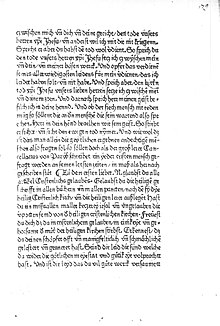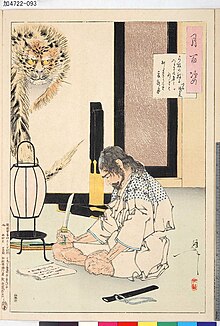last words
The last words are what a person leaves for posterity in the face of death. They have been considered worth preserving by various peoples for millennia. Although they are not always unequivocally vouched for, some have found their way into the proverbs and memories of the world. They also play a major and sometimes important role in the visual and performing arts as well as in literature and music.
There are three types of last words in the strict sense:
- Before natural death: Because death usually appears for a long time, the last words can be well thought out (examples: Berrigan and Luther). Even more random last words are possible (examples: Goethe and Schiller ).
- Before sudden death: If the end comes very suddenly, there is no time for elaborate monologues. In the case of a murder or a heart attack, one can often only observe random last words (examples: Caesar and Kennedy ).
- Before the execution: If convicts stand in front of the gallows , the guillotine or the firing squad, one can count on well-considered last words. This can be the affirmation of innocence, a confirmation of one's own opinion, gallows humor or a curse, threat or warning to the judge (examples: Ferrer or Robert Blum ).
In a broader sense, one also understands the following under last words:
- Farewell letters: A suicide note is often left behind, in which motives can also be described (examples: Nicolas Chamfort and Dalida ).
- Last surviving words: If no last words in the narrower sense are known, other remnants are sometimes cited, for example the last entry in the diary ( Anne Frank ), last letters from soldiers home or from resistance fighters from prison ( Julius Fučík ), last notes from explorers ( Robert F. Scott ), grave inscriptions or wills (“ last will ”, example: Francis Bacon ).
Words fixed in writing by hand have the advantage that they can be verified. You just have to examine the document and prove that it is authentic and the last. In the case of orally transmitted last words, however, it is more difficult to decide whether the transmission is reliable.
For their author, last words can also have the aim of staging, stylizing or taking stock for posterity.
history
Even the early civilizations recorded the last words of important personalities. In Greek mythology , the dying had the gift of prophecy . Thus the dying Patroclus prophesied his conqueror Hector in the Iliad that he would die soon. The last words of some Greek philosophers are also known ( Anaxagoras , Archimedes , Epicurus , Plotinus , Socrates ) and Suetonius handed down at least five last words in his books about the first twelve Roman emperors (from Augustus, Caesar, Galba, Nero and Vespasian). But the last utterances were not only relevant in Western culture. The Chinese and Indian peoples also left some behind. Examples are Zhuangzi and Buddha .

With the rise of Christianity , the last words of many martyrs were recorded as testimonies of steadfastness in faith until death. However, the record was often not made until generations after death and served certain purposes, for example the establishment of a canonization or the creation of a morally imitable model, so that doubts can be justified in such a tradition. At the end of the Middle Ages, so-called Artes moriendi arose under the influence of the epidemics that were rampant at the time and the fear of an unprepared death (patron saint: Christophorus ) . They taught the art of dying in the style of Christ. So the last words should be based on his last words : “Lord, I command my spirit into your hands.” Luther and Columbus , among others, adhered to these words .
But there were also personally worded last words, which in turn could then be regarded as exemplary. In 1595 , Michel de Montaigne expressed the wish for a compendium of last words:
- “Et n'est rien dequoy je m'informe si volontiers, que de la mort des hommes: quelle parole, quel visage, quelle contenance ils y ont eu: ny endroit des histoires, que je remarque si attentifvement… Si j'estoy faiseur de livres, je feroy un registre commenté des morts diverse. "
- ("There is nothing I inquire more thoroughly than how a person died: with what words, what face and what posture; and there is no other place in the history books to which I pay such attention ... If I were a book writer, I created an annotated register of the various deaths. ")
The first collections of last words were created in the 17th century, although initially they were still very specialized in martyrs as good and criminals as bad examples. It was not until the 19th century that there were more general anthologies .
In England in the 18th and 19th centuries, it was common for murderers to read so-called dying declarations on the scaffold , which were then distributed as flyers. These leaflets always followed a certain scheme and didn't have a lot of individuality.
Thomas Alva Edison created his phonograph in 1877 to perpetuate voices, not least the last words:
- "For the purpose of the preserving the sayings, the voices and the last words of the dying member of the family - as of great men - the phonograph will unquestionably outrank the photograph."
- (Emphasis in the original, "For the purpose of preserving the speeches, the voices and the last words of dying family members - as well as of great men - the phonograph will undoubtedly surpass photography in importance.")
In the late 19th century, people usually died at home with their families, who were able to pass the last words on to the public. In the 20th century, dying moved from the private sphere to the hospital, the care of the dying was passed on from relatives to technical equipment and medical staff, so that in the course of the depersonalization of the dying process, even the last words were heard and saved less often.
Today the last words are a must for every biography. And even if - as with Einstein - nothing has come down to us, it will explain why there are no final statements.
Japan

A special tradition of the last words has developed in Japan. There the dying write down self-composed poems of death ( jisei ). In some cases they only communicate this verbally. The oldest surviving death poems come from writings of the eighth century ( Kojiki , Man'yōshū , Kokin-wakashū ). This tradition is maintained to this day, for example most Japanese officers and many kamikaze pilots left poems of death in the Second World War .
They were mostly written in the tanka form (31 syllables in five lines in the order 5 + 7 + 5 + 7 + 7), and since the 16th century also as haiku (three-line characters with 5 + 7 + 5 syllables).
Images from nature and the seasons play a major role in death poems. As symbols of transience, flowers are chosen that hardly bloom and wither again, or dew that evaporates when the sun rises. Other motifs that are often used are clouds and mountains, since the Japanese imagined death as a journey into the mountains, into the sky or into the clouds. The moon is also popular as a symbol of enlightenment.
Ōta Dōkan (see there) and the Buddhist monk Saigyō wrote their death poems as tanka:
|
|
Retsuzan (1789–1826) used the haiku form:
|
|
The world of the dew means the world of people: ephemeral like a dream from which one awakens and finds oneself in the Pure Land in the west , i.e. in Buddhist paradise. As a last example the death poem of Uko (1686–1743):
|
|
A spelling of hototogisu ( gackle cuckoo , lat. Cuculus poliocephalus ) consists of the Chinese characters “time” and “bird”. The “time bird” is often a messenger of death in poetry.
Idioms
Until well into the 17th century, the dying word was still understood to mean the “word of a dying man”, the last words. From the 18th century onwards it was only used eloquently, mostly in negative expressions: “don't say a word for word” as a synonym for “say nothing at all”.
literature
General
- Walter Hömberg : "Last Words" , in: Universitas, 70th year 2015, No. 830, pp. 28–39, ISSN 0041-9079
- Cornelius Hartz: You see, that's how you die! 55 best last words , Philipp von Zabern, Darmstadt 2012, ISBN 978-3-8053-4505-7
- Hans Halter : I've done my thing here. Lives and last words of famous women and men , Bloomsbury, Berlin 2007, ISBN 978-3-8270-0697-4
- Werner Fuld : Lexicon of the Last Words. Last messages from famous men and women from Konrad Adenauer to Emiliano Zapata , Piper, Munich 2002, ISBN 3-492-23656-1
- Michael Augustin : No more! Last moments of famous women and men , Sanssouci, Zurich 2000, ISBN 3-7254-1180-8
- Karl S. Guthke : Last words. Variations on a theme of the cultural history of the West , CH Beck, Munich 1990, ISBN 3-406-34443-7
- Isabelle Bricard: Dictionnaire de la mort des grands homme . Le Cherche Midi Éditeur, Paris 1995, ISBN 2-86274-391-7
Japan
- Yoel Hoffmann: The art of the last moment. Death poems of Japanese Zen masters , Herder, Freiberg, Basel, Vienna 2000, ISBN 3-451-04965-1
music
- Klaus Langrock: The seven words of Jesus on the cross. A contribution to the history of the passion composition , Die Blaue Eule Verlag, Essen 1987, ISBN 3-89206-203-X
- The seven last words of Jesus in music . Manuscripts and prints from the Regensburg Episcopal Central Library. Schnell & Steiner, Regensburg 2001, ISBN 3-7954-1418-0
Radio
- Erich Klein : Last words - the final in literature , long version of a contribution from the Ö1 series Diagonal , June 20, 2020
Web links
Individual evidence
- ^ Alfred Sobel: On the charm of self-staging. When the 'last hour' has struck: about the last words. In: Neues Deutschland from 25./26. November 2017, p. 22
- ↑ [1] transcription
- ↑ Thomas Edison: The Phonograph and its Future, in: North American Review, Volume 126, Issue 262 (May-June 1878), pp. 527-36, especially pp. 533f
- ↑ mortal word , n . In: Jacob Grimm , Wilhelm Grimm (Hrsg.): German dictionary . tape 18 : Stehung – Stitzig - (X, 2nd section, part 2). S. Hirzel, Leipzig 1941, Sp. 2438 ( woerterbuchnetz.de ).
- ↑ "Everything has an end, just ..." - "Diagonal" ends , Radio Ö1, June 20, 2020